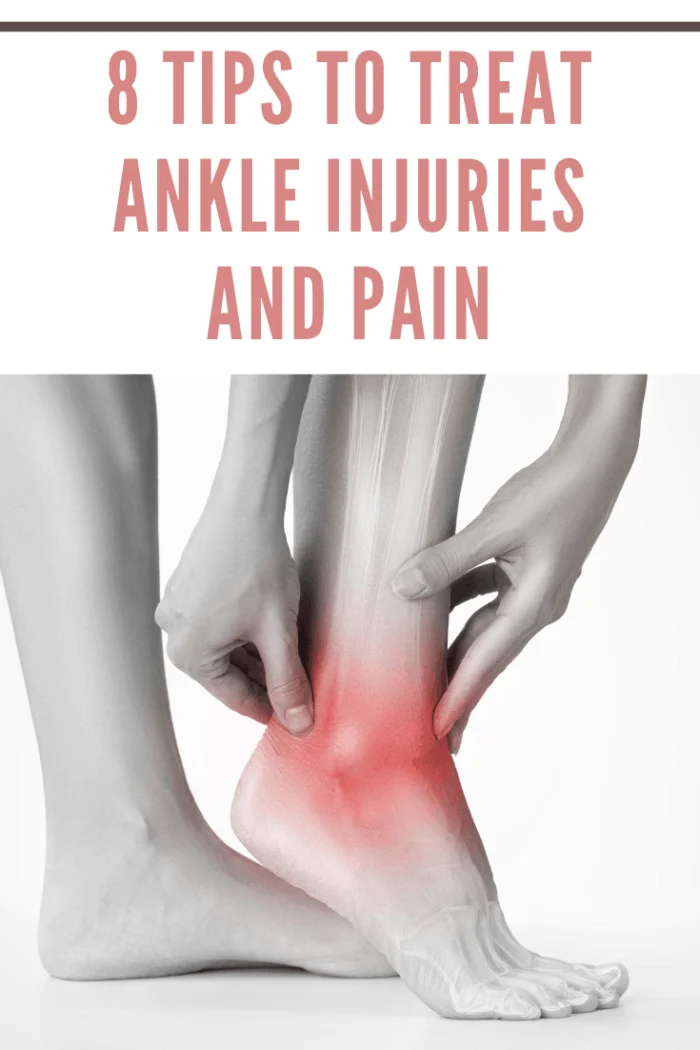Ankle injuries and pain typically stem from sports injuries. However, one does not need to be a professional athlete to end up with an ankle injury. Even simple daily activities such as jogging, walking on uneven terrain, or accidentally twisting your foot can result in an uncomfortable, debilitating sprain. In some severe cases, you can even end up with a fracture or other severe conditions of the ankles.
Remember that everyone is at risk for injuries or other conditions of the ankles at any age. That being said, males between the ages of 15 and 24 are most susceptible to an ankle sprain. Most of cases of ankle sprains often occur when engaging in athletic activity. Some of the usual ankle injuries include sprains and fractures involving the ligaments and ankle bones. In some cases, you might strain or tear a tendon.
There are several treatment options depending on the type of ankle injury:

First Aid for an Ankle Injury
When caring for an ankle injury, always remember the RICE method, which stands for rest, ice, compression, and elevation.
Rest.
Allow the ankle to rest by keeping your weight off it. The objective is to prevent further damage.
Ice.
Once you apply ice to the ankle, it works by slowing down or reducing the swelling and provides a numbing sensation that relieves the discomfort. An ice pack should be applied within 48 hours of getting the injury. Do not leave the ice pack on the site for more than 20 minutes to prevent frostbite from developing. Allow the area to rest and wait for at least 45 minutes before reapplying an icepack so that the tissues can return to standard temperature. Repeat the application of ice as needed. Use a layer of cloth or towel between your skin and the ice bag, which serves as a barrier so that your skin doesn’t become overly chilled before the muscle and deeper tissues get a chance to benefit from the icing.
Compression.
Secure the ankle with a compression wrap or an elastic bandage to immobilize and support it. Avoid wrapping too tightly. If your toes start to turn bluish in appearance, become color, or lose sensation, it simply means that the wrap may be too tight.
Elevate.
Raise the ankle with cushions or pillows above your heart to lessen the discomfort and swelling.
Avoid placing any weight on the ankle until a doctor has assessed it. When sprains or fractures are ignored or poorly treated, it can result in lasting chronic issues with the ankle, such as weakness, repeated injury, and even arthritis in the long run.
Pain Management
For most ankle injuries, one way to control the discomfort is to use an over-the-counter medication such as acetaminophen (MedlinePlus) or a non-steroidal anti-inflammatory drug (NSAID), ideally ibuprofen and naproxen.
Orthopedic Shoe Insert/Foot or Ankle Brace
A non-surgical approach that aims to realign the joints and minimize ankle pain is to use an orthopedic shoe insert or an ankle or foot brace. Orthopedic shoe inserts are available in various sizes and levels of stiffness. The inserts can support the different sections of the foot while also redistributing body weight, thus easing the pain.
Foot or ankle braces work similarly and are available in various sizes and levels of support. You can wear some models with your regular shoes, while other variants might look similar to a cast covering the ankle and the foot.
Steroid Injections
Another option to help lessen ankle pain and swelling is steroid injections, explains Healthline. Generally, the injections include a corticosteroid, which reduces the pain, swelling, and stiffness in the site.
Most injections will take a short while and give relief in just a few hours, while the therapeutic effect can last from 3–6 months. An advantage of this approach is its non-invasive nature.
Ankle Sprain Care
When a person has an ankle sprain, the treatment depends on the severity of the injury—mild, moderate, or severe. Surgery is the last option if extensive damage involves more than the ligaments or other treatment options fail to work.
Mild.
Use the RICE method for a mild ankle sprain until the pain and swelling settle. The doctor usually allows you to place weight on the ankle after 1–3 days and prescribe stretching, range of motion, and strengthening exercises.
Moderate.
The doctor will use the RICE method but allows more time for healing. You might use a splint or boot to immobilize the ankle. The doctor prescribes exercises to improve the motion range and strengthen the ankle as part of the treatment. Physical therapy will help restore the full use of the ankle.
Severe.
This ankle injury involves a full tear or rupture of the ligament and takes longer to heal, explains Very Well Healthy. Treatment involves immobilization of the joint. There is a lengthier time for physical therapy to improve the range of motion and stretching and strength-building exercises.

Ankle Fracture Care
When a person has an ankle fracture, the doctor will manage it surgically or non-surgically. The doctor might treat the injury with immobilization of the ankle if only a single bone breaks, if there is no misalignment of the bones, and the ankle is secure. The doctor will place a brace that functions as a splint or apply a cast.
In case the joint is unstable, it requires ankle surgery. The doctor stabilizes the ankle using a metal plate and screws to secure the bones. After surgery, the doctor applies a splint until the swelling subsides and then with a cast.
After this kind of procedure, be sure that you keep weight off the ankle to allow the bones to heal in the right alignment. Once it is safe to start moving the ankle, you will need physical therapy, which provides balance, gait, strengthening, and mobility exercises. Your therapist will suggest a distinct program to help you regain normal functioning. Remember that it might take several months until your normal walking pattern returns without any limping or discomfort.
Care for Ankle Tendon Injuries
Trauma or overuse can cause the muscles or tendons in your ankle to become swollen or damaged. When inflammation develops, it is called tendonitis. Sometimes, they might tear, fully rupture, or move out of place.
When dealing with tendon injuries, the treatment options are the same as the care for sprains:
• Immobilizing the ankle with a splint or cast
• Anti-inflammatory medications, either oral or injected, to lessen the discomfort
• Using a brace to provide support during activities
• Physical therapy to improve the range of motion, balance, and strength
• In severe instances, surgical intervention might be the only choice to fix the tendon and often to repair the supporting foot structures
Ankle Arthritis Care
If your ankle pain is brought about by arthritis, you cannot completely resolve the pain. Remember that different types of arthritis require specific treatment. Common types that can affect the ankle include osteoarthritis, rheumatoid arthritis, post-traumatic arthritis, and even gout. Arthritis has no cure, but there are options to ease the pain and improve function. There are ways to manage discomfort, such as the following:
• Applying topical pain medications
• Take non-steroidal anti-inflammatory drugs (NSAIDs) to lessen the pain, swelling, and inflammation
• Observe healthy eating habits
• Maintain an active lifestyle and follow a fitness regimen that includes moderate exercise
• Include a stretching routine to maintain a good range of motion
• Keep your weight within the recommended range to help reduce the stress on your joints.
Causes of Ankle Injuries
Damage to the ankle occurs once it is twisted excessively out of its normal position. Most ankle injuries are likely to occur when a person engages in sports or while walking or running on uneven surfaces that force the foot and ankle into an unnatural position.
When both the foot and ankle are in an unnatural position while wearing high-heels or loose, unstable sandals or clogs, this also contributes to ankle injuries. Aside from inappropriate footwear, ankle injuries can also occur due to the following:
• Falling or tripping
• Abrupt or sudden impact from something like a vehicular accident
• Rolling of the ankle joint
• An awkward landing after a jump
• Running or walking on uneven terrain
What are the Indications of Ankle Injuries?
Depending on the type of ankle injury, the signs of a sprain and a fracture are strikingly similar. In some instances, you might mistake a fracture for a sprain. With this in mind, it is vital to consult a doctor so that an ankle injury will undergo proper assessment.
Some of the usual indications of ankle injuries include the following:
• Pain or discomfort, typically abrupt and intense
• Bruising
• Swelling or inflammation
• Difficulty in walking or bearing weight on the affected joint
The ankle might be rigid or stiff if you suffer from a sprain. The site is usually tender to the touch for a fracture, and the joint seems misaligned or deformed. There is minimal discomfort and swelling for a mild sprain, while a severe case involves extensive pain and swelling.
When there is tearing of the peroneal tendon or tendonitis often results in discomfort or pain and swelling. Additionally, the ankle will feel warm to the touch if you have tendonitis. As for an acute tear, there is weakness or instability of the foot and ankle.
Tendinosis, involves the degeneration of the tendon tissues but might involve a certain degree of inflammation.
Tendinosis often takes years to develop, and the usual symptoms include the following:
• Weakness or instability in the ankle
• Pain that is sporadic on the external part of the ankle
• Increasing height in the arch of the foot
Prevention of Ankle Injuries
Although there are several ways to deal with ankle injuries and the ensuing pain, it is better to find ways to prevent them from occurring in the first place. Let us look at several ways to lower your risk of ending up with an ankle injury.
• Maintain a well-balanced diet
• Avoid scenarios that increase your risk for falls.
• Steer clear from any physical activity such as sports or exercise if you are tired or experiencing discomfort
• Exercise regularly by including routines that help strengthen the core and ankle strength. Try to incorporate exercises focusing on hip, back, and abdominal strengthening, such as lunges, squats, and dips.
• Use footwear that properly fits and is suitable for the activity you are engaging in.
• Always perform proper conditioning for the specific sport you are playing.
• Run or jog on flat surfaces and avoid those that are uneven or rough
• Always include proper warm-up and stretching exercises before engaging in a sport or exercise.
• Use the appropriate equipment in a sport you are playing.
Always have a first aid kit available that includes essential supplies such as bandages, ice packs, tensors, splints, and medications at all times. These preventive measures and your first aid kit will lower your risk for ankle injuries.
You are ready to manage the resulting pain or discomfort and the accompanying symptoms in case one occurs. Once you provide proper care, make sure that you will contact a doctor for further care.
Final Thoughts
According to Mayo Clinic, when it comes to ankle pain, it is often due to common injuries such as a sprain or other medical conditions such as arthritis or even nerve damage. In most cases, the discomfort manifests as swelling or bruising lasting for 1–2 weeks.
While you are recuperating, it is best to take a break from any activity, raise your foot, and apply an ice pack at least 3–5 times throughout the first few days. To ease the discomfort, you can take over-the-counter pain medications for relief.
In case the pain is persistent, consulting a doctor might be the best option where several treatment options are available, ranging from orthopedic boots, braces, corticosteroids, or even surgery as a last resort.
